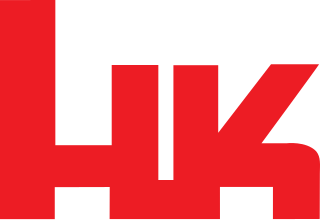
Heckler & Koch GmbH is a German defense manufacturing company that manufactures handguns, rifles, submachine guns, and grenade launchers. The company is located in Oberndorf am Neckar in the German state of Baden-Württemberg, and also has subsidiaries in the United Kingdom, France and the United States.
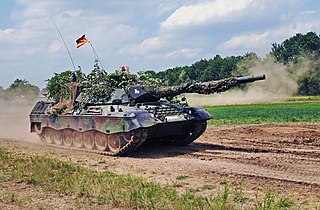
The Kampfpanzer Leopard 1 is a main battle tank designed by Porsche and manufactured by Krauss-Maffei in West Germany, first entering service in 1965. Developed in an era when HEAT warheads were thought to make conventional heavy armour of limited value, the Leopard design focused on effective firepower and mobility instead of heavy protection. It featured moderate armour, only effective against low caliber autocannons and heavy machine guns, giving it a high power-to-weight ratio. This, coupled with a modern suspension and drivetrain, gave the Leopard superior mobility and cross-country performance compared to most other main battle tanks of the era, only being rivaled by the French AMX-30 and Swedish Strv 103. The main armament of the Leopard consisted of a German license-built version of the British Royal Ordnance L7 105 mm rifled gun, one of the most effective and widespread tank guns of the era.
The MG 42 is a German recoil-operated air-cooled general-purpose machine gun used extensively by the Wehrmacht and the Waffen-SS during the second half of World War II. Entering production in 1942, it was intended to supplement and replace the earlier MG 34, which was more expensive and took much longer to produce, but both weapons were produced until the end of World War II.

The Leopard 2 is a third generation German main battle tank (MBT). Developed by Krauss-Maffei in the 1970s, the tank entered service in 1979 and replaced the earlier Leopard 1 as the main battle tank of the West German army. Various iterations of the Leopard 2 continue to be operated by the armed forces of Germany, as well as 13 other European countries, and several non-European countries, including Canada, Chile, Indonesia, and Singapore. Some operating countries have licensed the Leopard 2 design for local production and domestic development.

The Boxer is a multirole armoured fighting vehicle designed by an international consortium to accomplish a number of operations through the use of installable mission modules. The governments participating in the Boxer programme have changed as the programme has developed. The Boxer vehicle is produced by the ARTEC GmbH industrial group, and the programme is being managed by OCCAR. ARTEC GmbH is based in Munich; its parent companies are Krauss-Maffei Wegmann GmbH and Rheinmetall Military Vehicles GmbH on the German side, and Rheinmetall Defence Nederland B.V. for the Netherlands. Overall, Rheinmetall has a 64% stake in the joint venture.
The Heckler & KochG36(Gewehr 36) is a 5.56×45mm NATO assault rifle designed in the early 1990s by German weapons manufacturer Heckler & Koch as a replacement for the heavier 7.62×51mm G3 battle rifle. It was accepted into service with the Bundeswehr in 1997, replacing the G3. Since then, it has also been a popular export, and the G36 has seen active service in military and police units in several countries, including Germany, Spain, and the United Kingdom. The G36 is gas-operated and feeds from a 30-round detachable box magazine or 100-round C-Mag drum magazine.

The Wiesel Armoured Weapons Carrier (AWC) is a German light air-transportable armoured fighting vehicle, more specifically a lightly armoured weapons carrier, produced by Rheinmetall. It is quite similar to historical scouting tankettes in size, form and function, and is the only true modern tankette in use in Western Europe.

The Schützenpanzer Marder 1 is a tracked German infantry fighting vehicle designed for use with the West German Panzergrenadiere units, mechanized infantry specialized for IFV combat. It has been operated by the German Army as the main Panzergrenadiere IFV from 1970s through to the present day. Developed as part of the rebuilding of West Germany's armoured fighting vehicle industry, the Marder has proven to be a successful and solid infantry fighting vehicle design.

The MG 3 is a German general-purpose machine gun chambered for the 7.62×51mm NATO cartridge. The weapon's design is derived from the World War II era MG 42 that fired the 7.92×57mm Mauser round.

Infanterist der Zukunft is the German Bundeswehr's program as part of the Future Soldier project. It is a modular, integrated fighting system designed to provide significant lethality, survivability, mobility, battle command, and training to the German infantryman. It is being developed by EADS Defence Electronics and Rheinmetall-Detec.
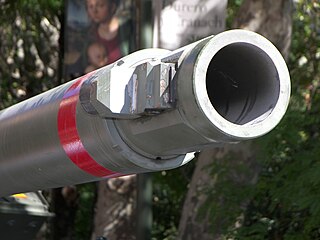
The Rheinmetall Rh-120 is a 120 mm smoothbore tank gun designed and produced in former West Germany by the Rheinmetal-DeTec AG company, it was developed in response to Soviet advances in armour technology and development of new armoured threats. Production began in 1974, with the first version of the gun, known as the L/44 as it was 44 calibres long, used on the German Leopard 2 tank and soon produced under license for the American M1A1 Abrams and other tanks. The 120-millimetre (4.7 in) gun has a length of 5.28 metres (17.3 ft), and the gun system weighs approximately 3,317 kilograms (7,313 lb).

The AA-12, originally designed and known as the Atchisson Assault Shotgun, is an automatic combat shotgun developed in 1972 by Maxwell Atchisson. The most prominent feature is reduced recoil. The current 2005 version has been developed over 18 years since the patent was sold to Military Police Systems, Inc. The original design was the basis of several later weapons, including the USAS-12 combat shotgun. The shotgun fires in fully automatic mode only. However, the relatively low cyclic rate of fire of around 300 rounds per minute enables the shooter to fire semi-automatically de facto with brief trigger pulls. It is fed from either an 8-shell box magazine or a 20-shell drum magazine.

The Puma is a German infantry fighting vehicle (IFV) designed to replace the aging Marder IFVs currently in service with the German Army. Production of the first batch of 350 vehicles began in 2010 and was completed in August 2021. A second batch of 229 Pumas received funding. Mass production began on 6 July 2009. The companies responsible for this project are Krauss-Maffei Wegmann and Rheinmetall Landsysteme, which created a joint venture, Projekt System Management GmbH (PSM). The Puma is one of the world's best-protected IFVs, while still having a high power-to-weight ratio.

The Rheinmetall LandSysteme Light Infantry Vehicle for Special Operations, or LIV (SO), is a German light armoured utility vehicle based on the Mercedes-Benz G-Class. It is also known by the names Serval, Wolf, and AGF. As the name implies, the LIV (SO) is designed specifically for use by special operations forces, and has light armour, high mobility and high firepower. Development of the vehicle started in 2002, and 21 were procured by the German Army for the KSK special forces in 2004. An unspecified number of vehicles were delivered to the Swiss Army in 2007.
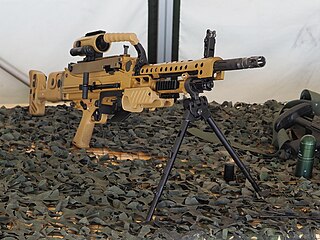
The Heckler & Koch MG5 is a belt-fed 7.62×51mm NATO general-purpose machine gun manufactured by German firearm manufacturer Heckler & Koch. The MG5 resembles the 5.56×45mm NATO Heckler & Koch MG4 light machine gun, which was adopted into German military service in 2005.
The Rheinmetall RMG 7.62 is a machine gun under development by Rheinmetall Defence. The weapon comes with 3 rotating barrels to reduce overheating and erosion during a firefight.
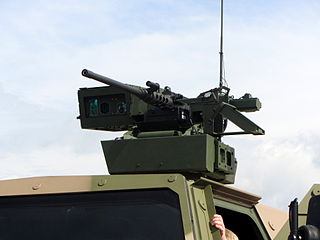
FLW stands for "remotely operated, light weapon station" developed by the German defence company Krauss-Maffei Wegmann brands its family of remote weapon stations.

The Lynx is a German armoured fighting vehicle developed by Rheinmetall Landsysteme. The Lynx, configured as a KF31 infantry fighting vehicle (IFV), was unveiled at the Eurosatory defence exhibition on 14 June 2016. The KF41 variant was unveiled at the Eurosatory defence exhibition on 12 June 2018. According to Rheinmetall, the Lynx family of tracked armoured vehicles is at the forefront of a new trend in IFV design toward armoured vehicles with lower unit and through-life costs and reduced complexity. One of the key principles of the Lynx concept is the integration of proven sub-systems with a high technology readiness level to reduce development time, cost and technical risk.

The Leopard 2PL is a main battle tank used by the Polish Armed Forces, and is a modernized version of the older Leopard 2A4 tank, phased out by Germany and first acquired by Poland in the 2000s. The modernisation is currently being carried out in cooperation with Rheinmetall and the Polish Armaments Group.















